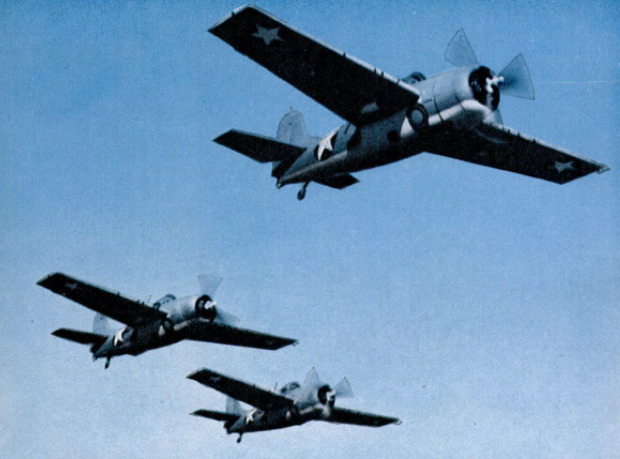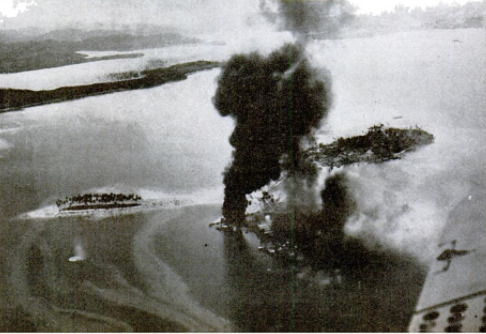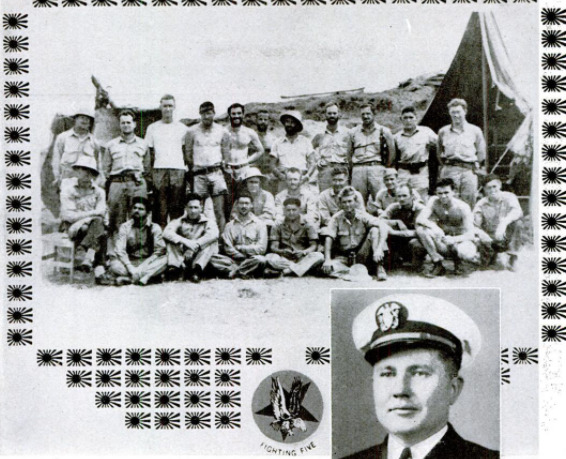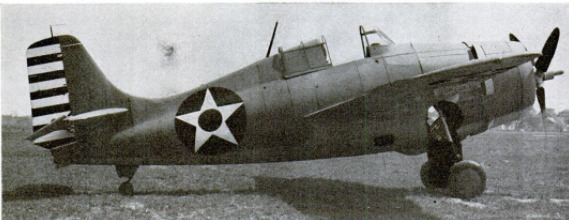-
Title (Dublin Core)
-
Navy Fighter Squadron Five
-
Article Title and/or Image Caption (Dublin Core)
-
Title: Tojo meets a wildcat
-
extracted text (Extract Text)
-
FIGHTING Squadron Five, U.S.N,, led by
lieutenant Commander Leroy C. Simp-
ler, 37 years old, of Lewes, Del, brought
down 77 Japanese planes, probably another
13, and contributed to the destruction of
three more during the fighting in the Solo-
mon Islands from August 7 to October 15,
1942.
In helping protect the landings of United
States Marines on Guadalcanal, August 7
and 8, Fighting Five destroyed 13 enemy
bombers, damaged two more bombers and
two Zeros. On August 24, when the Japa-
nese launched a determined attack on the
island, Fighting Five destroyed 19 enemy
planes, including 14 dive bombers. The re-
mainder were destroyed in the 34 days
that the squadron was based on Guadalcanal.
For its performance in all this fighting,
the squadron received the congratulations
of Admiral William F. Halsey, Commander
of the South Pacific Area, and its com-
mander received the Distinguished Flying
Cross and Navy Cross from Secretary of
the Navy Frank Knox, on behalf of the
President.
This squadron of fighting men flew an
airplane known as the Wildcat, the product
of the Grumman Aircraft Engineering Cor-
poration, Bethpage, N. Y. The Grumman
Wildcat has been the principal fighting
plane for the U. S. Navy and Marine Corps
since Pearl Harbor. The Grumman com-
pany has delivered more fighting planes to
the Navy than any other manufacturer. For
its services it has been cited by Rear Ad-
miral John S. McCain, U.S. N., Chief of the
Bureau of Aeronautics, as follows:
“The name ‘Grumman’ on a plane or a
part has the same meaning to the Navy as
the word ‘Sterling’ on silver.”
Designated F4F4 by our Navy, the Wild-
cat is also supplied to the British Navy and
is known in that service as the “Martlet.”
It is a single-engined, single-seat, midwing,
all-metal monoplane with retractable land-
ing gear, designed to operate from carriers
or land bases. Its wing span is 38 feet;
over-all length, 28 feet, 11 inches; height on
the ground, nine feet, two inches.
Wildcats flown from carriers or from
Henderson Field on Guadalcanal by either
Navy or Marine pilots helped bring victory
at the Solomons, at Midway, and in other
Pacific battles. Fighting Squadron Five of
the Navy, which carried the ‘striking
eagle” as an emblem, was typical of the
men who used it.
There were 36 original members of this
squadron, and 14 more flying officers were
assigned to it during fighting in the Solo-
mons. These flyers averaged 24 years old.
They came from 26 states. Nine are now
listed as missing in action; three are known
to have been killed. Seven were wounded.
The squadron, which first went into ac-
tion August 7, had an average training of
12 months per man. Many of the fighters
had more training. Four were Annapolis
graduates, and the rest were brought into
the squadron from the reserve as the Navy
expanded. The squadron was decommis-
sioned in December, 1942, and its members
are now scattered in other duties. Com-
mander Simpler is in Washington, D.C.
attached to the Navy Department.
“We first got these Wildcats in Bermuda,
in June, 1941,” Commander Simpler says.
“They created quite a stir among the per-
sonnel. Naturally, the squadron com-
mander insisted on being the first to fly
one. It gave us 50 percent better perform-
ance in practically everything than the
planes we'd flown before. It took a little
time to get used to them, because there is
a lot of difference between making a run
on a target at around 200 miles an hour
and at around 120. It took time to adjust
ourselves to formation flying, carrier land-
ings, and everything else.
“But we were trained all right by the
time we reached the Solomons. Trained in
teamwork. Teamwork is everything.
“Because of this training, there wasn't
half the excitement the first morning we
went into action that there was when we |
boarded the carrier to go out on the Pacific,
knowing we were going to get into action.
We were absolutely confident. We had our
instructions. We knew our planes. We
knew what we were going to do, and we
did it. |
“Our first mission was to protect Marine
landings on Guadalcanal, and our take-off
from the carrier was before dawn. The
take-off was pretty. The air was perfectly
smooth. The moon was still a few degrees
before setting. The ceiling was fairly high
and broken. Ours was an attack group
composed of 12 fighters. Its main mission
was to strafe Henderson Field, destroy any
aircraft found there, and sweep the adja-
cent area for any other fields that might
possibly be there.
“As we came up in the early dawn, we |
could see our own transports with their es-
corting cruisers and destroyers far beneath
us, and they were a beautiful sight. We
were just approaching our attack point
when the first U. S. warship opened up with
its guns. Our own attack was just like any
other strafing drill. We saw hangars below
us and we went down and let them have it.
There was a truck running across the field
and we destroyed it absolutely. Then we
roved around, strafing the buildings under
the trees that we supposed must contain
the Japs. Then we went back to the car-
rier.”
A second patrol went out, Commander
Simpler says, which ran into an overwhelm-
ing force of Japs coming “down the high-
way” from Rabaul. They attacked, and
lost four out of eight, but a third patrol
went up and brought down 13 Japanese
planes definitely, four probably, with two
“assists,” without the loss of a single Amer-
ican plane.
“What is the margin of superiority of the
Americans over the enemy?" Commander
Simpler was asked.
“It’s the combination of man and plane,”
he answered. “Naturally, it's both, for the
best plane won't win If it isn't operated to
maximum efficiency. Up against the Jap
Zero we had the disadvantage of going
against plane with greater maneuverabil-
ity and greater climb. Our speeds were
about equal. But the Jap was in a tinder-
box. You hit him and he burns. The Wild-
cat is tough. It's got the armor and its
got the fire power. You win by taking ad-
Vantage of what you've got.
“The Jap pilot is brave, all right. But he
doesn't seem to be as alert as our pilots.
Many times he either doesn't see you, or
doesn't care to press an engagement. Maybe
if you were riding around in a tinderbox,
you'd develop a little disinclination to get
Bit. Their bombers burn just as quickly as
thelr fighters, and we've certainly brought
back our Wildcats full of holes.
“One man in our squadron, ‘Smoky’ Sto-
ver, even brought back his plane after a
head-on collision with a Jap float biplane.
He was so interested in shooting this Jap
that he didn't dodge him, and collided head-
on. The Jap plane went down into the sea,
but ‘Smoky’ brought his own plane home
with one wing bashed in."
The second major action for Fighter
Squadron Five occurred on August 24,
when a big Jap task force of transports,
carriers, cruisers, and battleships came
south from Rabaul in a vain attempt to re-
inforce the enemy forces on Guadalcanal.
As against 19 Japs brought down, Fighter
Squadron Five lost only three.
“Shortly after lunch aboard our carrier,”
Commander Simpler remembers, “enemy
patrol planes appeared near us and were
destroyed. Then our scouts picked up an
enemy carrier task force about 250 miles
away, and an attack group was launched
Which destroyed an enemy carrier. We
didn't escort these planes because the ac-
tion was too far away. We had our own
troubles protecting our own carriers.
“Japanese dive bombers came fn from
about 22,000 feet about 5:30 in the after-
noon. They were diving through a terrific
hall of antiaircraft fire, and right on thelr
tails our fighters followed. The first Jap to
drop a bomb was brought down immedi.
ately by the fighter on his tail. About three
quarters of the Jap bombers were destroyed
elther by our ships’ gunfire, by our fighters,
oF by our bombers returning home. During
the fight the enemy apparently put the
fight deck of one of our carriers out of
commission. There was a lot of hubbub
and confusion. We had two carriers in this
engagement, and when one Was temporar-
fly out of commission we made landings on
the other. Teamwork extended throughout
the entire task force.
“Soon after that fight, we flew our planes
to an island base near Guadalcanal and on
September 11 flew in to Henderson Field.
We certainly got great reception. There
were only eight planes remaining on the
island at that time, and all the ground
forces were glad to see us. The Japs were
fighting then at the very edge of the field.
“On the first morning's patrol we started
to find our planes while it was still dark
and rifle fire was crackling near by. I re-
‘member 1 stumbled Into a machine-gun pit.
A low, tense voice said, ‘What's the pass.
word, buddy?’ Nobody had given me any
password, and I knew I was pretty well cov-
ered. T said I was an American fiyer Jook-
ing for his plane, and the Marine in the
hole sald, ‘Okay, buddy.’ I was pretty re-
leved.
“In continuous fighting against Japanese
alr attack from
‘September 12 through October 15, Fighter
Squadron Five downed ive, four, eight, four,
ten, three, one, three, five, and (wo enemy
plabes, aa daily scores, besides six prob
Ses” The squadron was then evacuated
by ship and plane for & much-needed rest.
oly four of ita planes had been destroyed
by enemy action in the air, while based 00
Guadalcanal. During the evacuation by
‘hip we mourned the low of five of our men
42 remit of enemy bombing attack”
"Among the high scorers of the squadron
in planes shot down were Lieut. 1. 3. Jen-
sen, of SC Paul, Mina, with seven bombers
to his credit; Lieut C. B. Stakes, Junction
City, Kans. five bombers and a fighter:
List. ¥. i Register, Bismarck, N. D., one
bomber and four fighters; and Lieut. J. A.
‘Wesolowski, Detroit, Mich. four bombers
and n fighter. Twenty-seven other members
of the squadron brought down at least one
foe or more. They were ll tn there fight.
ing. ‘And. aa Commander. Simpler remem.
bers, “Aghting as a team.”
uch fn the record of the men who fy the
Navy's Wikicat. There are more than 20.
000 persons engaged In making either this
Sgr, or other Grumman planes for the
Navy at more than 13 plants scattered
about Long Island, N.Y. and more than
ne In five of the workers is 8 woman.
Production. of the Wildcat in how being
shared by the Eastern Alrcraft Division
of the General Motors Corporation. Three
men are the leaders 1 the proces of mami.
Tacture.—Leroy A. Grumman, president and
Chairman: Leon A. Swirbul, executive vice
president; and William T. Schwendier, chief
Cngineer. Grumman was in the Navy in
World War 1, Swirbul In the Marine Corps.
They organised the company in 1920 with
A Capital of $32,000, of which $13,000 was
Borrowed. As the result of bulding the
fncat fighting and torpedo bombing planes
for the ‘American Navy, this company in
creased ts gross sales of these weapons
from $4,482.35 In 1639 to $143.158.900.81
In 1042, producing planes often with 50
buildings to house parts of manufacture,
and subcontracting to hundreds of other
manuacturers
For thelr success in manufacture they
give credit primarily to “thousands of will-
ng hands” now working along the assem.
iY ines, while success n battle comes from
ha stout hearts and well-trained fying of
Navy airmen, wich as Fighter Squadron
Five, Planes and men such as theso have
fiven Toko something fo think about.
-
Contributor (Dublin Core)
-
Allen Raymond (Article Writer)
-
Language (Dublin Core)
-
eng
-
Date Issued (Dublin Core)
-
1943-08
-
pages (Bibliographic Ontology)
-
96-100, 204
-
Rights (Dublin Core)
-
Public Domain (Google Digitized)
-
Archived by (Dublin Core)
-
Matteo Ridolfi
-
Marco Bortolami (editor)
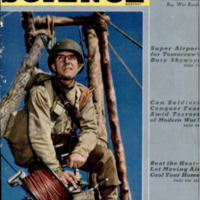 Popular Science Monthly, v. 143, n. 2, 1943
Popular Science Monthly, v. 143, n. 2, 1943

